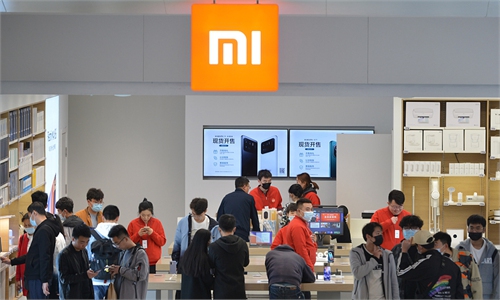Chinese smartphone brands gain foothold in Russia
Sales channels and supply chains bottlenecks for further expansion overseas

Photo: VCG
With South Korean electronics giant LG exiting the smartphone business and Huawei's market share continuing to fall due to the US' crackdown, Russian's smartphone market has seen the rearrangement of market players this year, with a group of Chinese brands including Xiaomi, OPPO and Vivo eyeing larger market share.
Xiaomi took the number one spot in the Russian smartphone market for the first time in the second quarter of 2021, with a market share of 32.8 percent, while former market leader Samsung saw its share fall to 28.3 percent, according to International Data Corporation (IDC)'s report in August.
Brands of the Chinese BBK group, including realme, held a combined 8.9 percent of the market, while Huawei slipped out top five spot, IDC data revealed.
Counterpoint Research analyst Soumen Mandal noted in a June report that he expects a strong competition between realme and Honor.
Meanwhile, Shenzhen-based Transsion Holdings, which has grown rapidly into a dominant player in the African mobile phone market, has been expanding to other markets including Turkey, Thailand and Russia. The brand's TECNO and Infinix launched a large-screen gaming smartphone in Russia this autumn, media reports said.
Russia's recovery from a second wave of the COVID-19 infections, along with the negative impact of US sanctions on Huawei's smartphone business and LG's exit from its loss-making smartphone business has benefited Chinese phone makers, according to analysts.
Russia's GDP growth rate hit 10.5 percent year-on-year in the second quarter - its strongest growth since 2000, as the economy rebounds after a sharp contraction due to the pandemic, data from Rosstat, Russia's federal statistics service department showed.
"Russian consumers are now mainly focused on low- and mid-range devices, and therefore Chinese tech companies' high price performance through large-scale output makes their smartphones popular in Russia," Sun Yanbiao, head of Shenzhen-based research firm N1mobile, told the Global Times on Monday, noting that LG's exit providers opportunity for emerging brands.
In April, the South Korean tech giant announced that it was closing its mobile business unit by the end of July. The wind down came after the firm was squeezed out of the high-end market by Samsung and Apple and Chinese brands including OPPO and Transsion Holdings, dragging down its global market share to only around 2 percent in 2020.
Challenges persist
While gaining a foothold in the international market on the back of technological prowess and competitive pricing, Chinese smartphone brands face challenges around sales channels and supply chains.
An anonymous smartphone marketing representative with a Chinese brand, which recently shifted focus from India to East Europe, told the Global Times on Tuesday that an appropriate pricing and channel strategy that fits local markets had proven to be more important than simply hardware differentiation to win customers.
"Unlike importing core components for final assembly in markets with high tariff barriers such as India and Pakistan, we haven't set up a factory in East Europe. There is a strong telecom carrier network that engages in the consumer mobile space, which makes it difficult for overseas smartphone brands to enter the market," he said.
After years of operation in overseas markets, OPPO and Vivo have gained channel margins by establishing an extensive sales and service networks, chuhaipost.com reported, citing a mobile phone agent in Russia. "Despite the challenge of pricing correctly when they newly enter a market, these brands are able to bring successful experience in mature markets in one or two years to the new market through exclusive agents and offline stores in a bid to maintain universal pricing," the insider said.
While Xiaomi competes with rivals leveraging its advantages across product value and sheer volume, it is also becoming more channel-friendly as it further expands in overseas markets. For Xiaomi, which is light-asset and brand-driven, channel agencies may think that the supply chain couldn't be guaranteed, while competition among them is chaos due to lack of universal pricing mechanism, the report said.
Troubled by the prolonged pandemic and tightened supply of crucial components such as chips, Chinese smartphone brands have been forced to rethink their regional strategies and focus efforts in more promising market, Sun said, referring to some Chinese brands' move of de-prioritizing shipments in the Indian market while shifting to markets such as Europe and Africa.
In the second quarter of last year, Chinese smartphone brands' total market share in India fell sharply from an all-time high of 81 percent to 72 percent, mainly due to the shutdown of factories and disruption of sales due to COVID-19 pandemic and associated lockdowns, followed by heightened anti-China sentiment in the country, according to the report by Counterpoint Research.
"Although the Indian market is large enough, it's not lucrative due to low consumption capacity, which is worsened by unrestrained outbreaks of COVID-19. The pandemic has led us to change our overseas strategy and place more efforts in Europe and Southeast Asia," the marketing personnel said, noting that more opportunities lie ahead for Chinese brands overseas.

